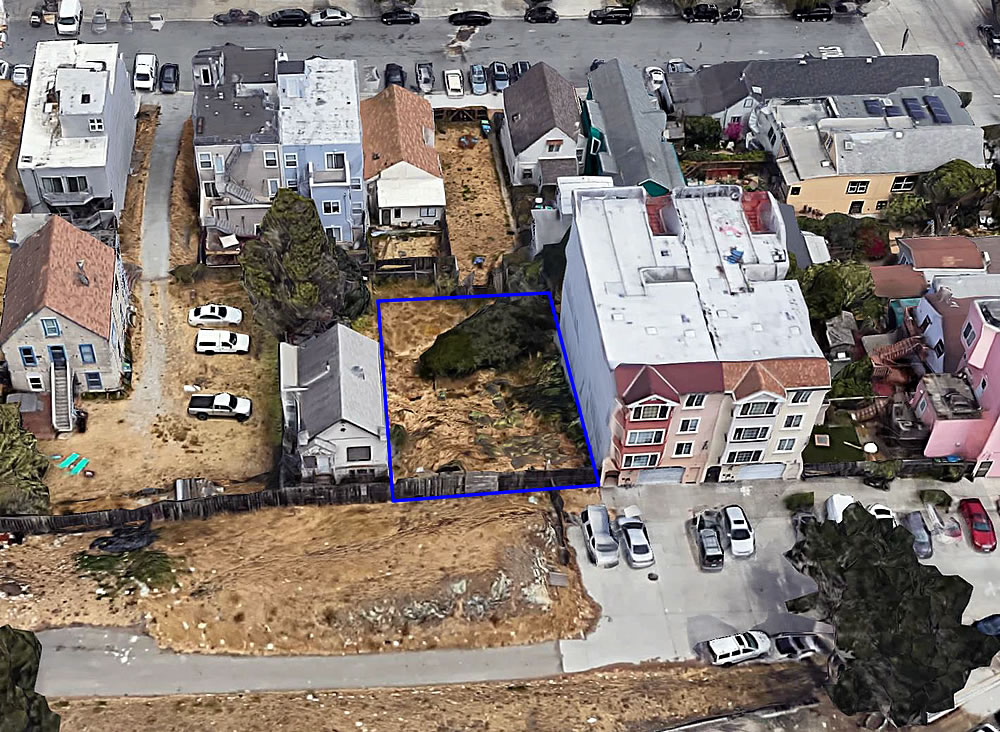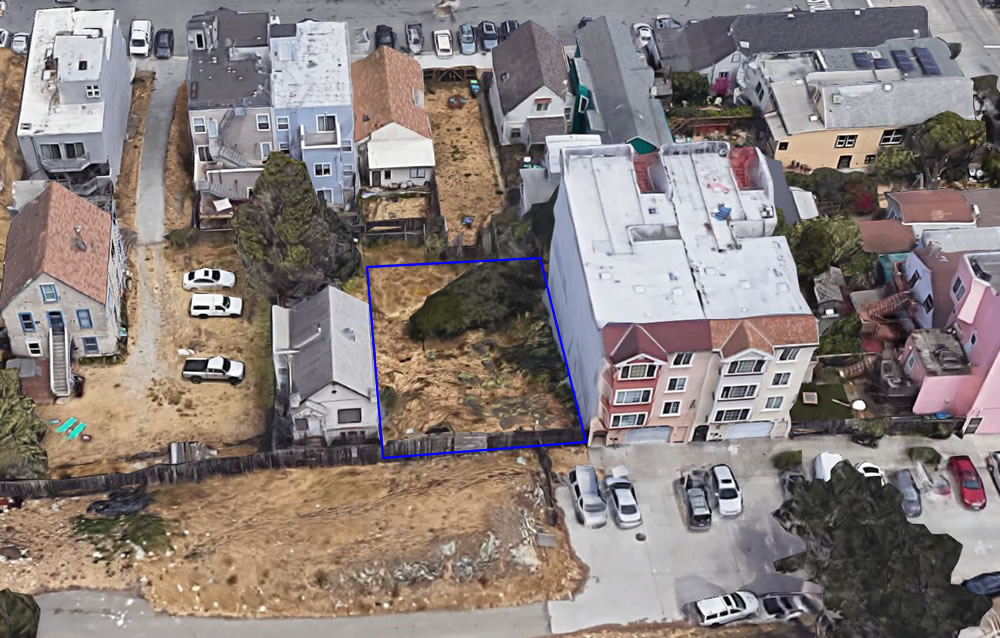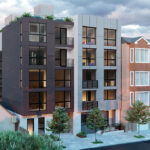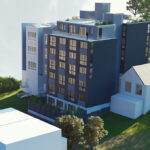Purchased for $1.7 million in September of 2018, plans to develop the two currently inaccessible Potrero Hill lots at 999 Texas Street have since been drawn and dubbed “1055 Texas.”
While the site is technically only zoned for development up to 40 feet in height and a maximum of five (5) dwelling units per its combined lot size and limitations, the proposed 25-unit development with a mix of 5 studios, 5 one-bedrooms, 14 twos and 1 three would rise up to 49 feet in height, as measured from Texas Street, on the downward sloping lot, leveraging San Francisco’s HOME-SF program for the additional height and density.
And while the project team would extend Texas Street for access and 50 linear feet of potential curbside parking, the proposed development, which is calendared to be approved by San Francisco’s Planning Commission next week, does not include any off-street parking spaces save a storage room for 25 bikes.





Since this development has no parking, I took a look at the transit situation.
Pro: 2 blocks from Caltrain.
Con: Significantly downhill from the 22 (soon to become the 55).
Con: Have to walk under 280 to get to the T.
Pro: It’s only a few blocks and there’s some cool stuff in that part of Dogpatch.
Not my first choice of neighborhood, but I would consider living there.
You better hope those cool spots in Dogpatch are able to stay in business.
Like the comments below, this area is an absolute hike to get to and boxed in all over
Dogpatch is going to thrive, and in short order. The arena and the runaway hit that is Crane Cove Park will assure that.
Heard that. Not to mention the Dogpatch Power Station and Pier 70 mega developments right down the hill. Sure, it will take a while to be fully built out, but what doesn’t in this city?
Runaway hit? It’s ok. Small stretch of rocky beach. Foul smell in the area a few times I was there. Super clean, but I wonder how long that will last post lockdown when the arena starts hosting games. Mostly seemed empty. Lockdown I guess, but by contrast I stopped going to Dolores Park because that seemed unsafely crowded all the time. I love this whole area during the lockdown becuase its so new and deserted, but longer term places near big arenas get dumpy in short order.
Every time I have been to Crane Cove, it has been quite active.
Yes, runaway hit, mark my words if you like. But it’s not a rocky beach. It’s a crescent shaped sandy beach. Plus there’s a whole other side with a huge grass field and on and on … oh well.
The arena isn’t going to help anything for months, if we’re lucky.
Do businesses have that luxury in waiting around?
Well, they’ll have a slightly easier time staying in business if there are 25 new units with a bunch of residents who don’t have cars, y’know?
I hope. If we get residents who actually go out and don’t door dash everything. Those people provide little.
That would be the basis for an awesome city & regional planning M.S. thesis project.
At what point does the patronization of “gig economy” services such as Door Dash, Uber, and so on completely defeat the purpose of building housing without off-street parking (the purpose, that is, other than making the development more profitable for the developer)?
What is the threshold? If the average resident of a new construction development without off-street parking utilizes such app-based services X times per week, when does that induce as much double parking and congestion in the surrounding neighborhood as if the development had off-street parking and directly accommodated private car use? This question is crying out for an answer, and of course it will have to be answered by the government because the greedheads at the “gig economy” companies act as if they have no impact at all. The residents in neighborhoods know differently. I run into random people working for these companies wandering around my building looking for the correct door multiple times per week. Meanwhile, their car is double parked on the street or in a red zone with the engine running.
I live a block away on Mississippi. The site is one block away from the 22, the 19, and the 48. It’s also a 7-10 min walk to both the T and Caltrain stops.
Looks like a good project. The rather decrepit house on the left of the top photo, 1033 Texas St, was listed for sale but delisted recently – I wonder if that parcel will see a similar project.
This block has to be one of the most bizarre in SF.
– “Texas Street” looks more like a walking pathway or very rural road that can barely fit one car. It goes quite a bit back around rock piles and dead-ends at a food bank. Bravo to Google Street View for making the drive all the way back.
– 1033 Texas, noted above, doesn’t have any access to Texas Street. From Street View sleuthing, it looks like there’s a walking pathway through an empty lot on Mississippi which connects to the house.
– Surrounded by low income housing projects, the 280 freeway, and industrial lots.
I think part of the incremental rebuilding of the public housing across the street includes connecting this part of Texas st with Missouri st and building out more rectilinear blocks. It’ll look less rustic when that’s done
My father was born at 925 Texas in 1921 and lived there with his family for about 10 years before they bought a place at Monterey and Joost. A few years ago the SF Chronicle had a story with an interactive overhead map of SF as it was in 1938 (sort of like a vintage 1938 google street view from overhead). Even then you needed to walk on a path to get to the few houses that were built there. I remember he told me there were more goats than people around that area.
Not quite 1938, but you can trace out the pace of civilization.
So only one bike in the bike storage per unit, even if you’re the 3-bedroom unit? Does anyone know if people trade/sell bike storage allotments? I’m sure some households might have no bikes, and some have two.
That said, bikes can and probably will be kept in the units themselves, if slightly awkwardly.
Not sure I would keep a nice bike in an easily accessible locker away from my sight.
Some context worth noting is the Potrero Annex / Terrace redevelopment by Bridge Housing, which is underway with residents relocating into the first new structures in late 2019. This project as I understand it includes building Texas St into a full street and connecting it through to Missouri.
Excellent design and rendering. looks exceptional next to the terrible pastel colored building at right.
I don’t think this will pencil out for a few years. Looking forward to an “entitled site” listing.
This is the best BMR housing picture I’ve seen on this site. Build it!
While six (6) of the units would be offered at Below Market Rates (BMR), per the terms of the City’s HOME-SF program, the majority of the units (19) would be market rate.